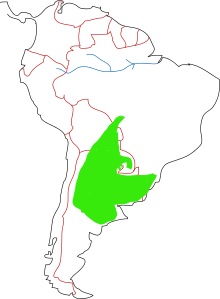Pampas fox
| Pampas fox | ||||||||||||
|---|---|---|---|---|---|---|---|---|---|---|---|---|

Pampas fox ( Lycalopex gymnocercus ) |
||||||||||||
| Systematics | ||||||||||||
|
||||||||||||
| Scientific name | ||||||||||||
| Lycalopex gymnocercus | ||||||||||||
| ( Fischer von Waldheim , 1814) |
The pampas fox ( Lycalopex gymnocercus , syn .: Pseudalopex gymnocercus ) is a South American species of real dogs . It is possible that it is not an independent species, but is attributable to the Argentine battle scarf.
features
The head-trunk length of the pampas fox is about 65 cm, its shoulder height about 40 cm. The fur is mottled with a single color. There is a characteristic black spot on the lower half of the rear. The tail is long, gray with 2 black spots, one at the base of the tail and the other at the tip. The eyes are noticeable: slanted and set forward. The average male weighs 6 kg, the female 4.6 kg.
habitat
The distribution area of the pampas fox are Chaco, the Argentine Monteregion, as well as the pampas , it extends from eastern Bolivia, western Paraguay, eastern provinces of Argentina: Salta, Catmarca, San Juan, La Rioja and Mendoza to the Atlantic and from southeast Brazil to the Argentine Rio-Negro- Province in the south.
The pampas grasslands are the typical habitat. Open areas with tall grass with humid to dry climates are preferred.
The IUCN lists the species as Least Concern .
Way of life
There is still some research to be done here. The food composition is very variable depending on the distribution area. Even fruits can make up up to 25% of the diet. It is believed that pampas foxes form permanent pair bonds. Its range depends on the conditions and can be between 130 and 270 hectares . The mating season is between August and October. The boys leave their nursery at the age of three months. As a rule, the male is responsible for procuring feed. The females become sexually mature at 8 to 12 months.
Systematics and evolution
There are currently 3 possible subspecies up for discussion:
- Lggymnocercus - subtropical grasslands of northeast Argentina, Paraguay, southeast Brazil
- Lgantiquous - grass pampas, undergrowth landscapes of Monte and the open Espinalpark lands, central Argentina
- Lglordi - Tacco, tropical ecosystems in the mountains of the Argentine provinces of Salta and Jujuy.
The boundaries are not clear and can hybridize there.
Web links
Individual evidence
- ↑ a b c d Mauro Lucherini: Wild dogs . Ed .: Udo Gansloßer, Claudio Silleo-Zubiri. Filander Verlag, 2006, ISBN 3-930831-63-5 , Der Pampasfuchs, p. 147 ff .
- ↑ Lycalopex gymnocercus in the endangered Red List species the IUCN 2008. Posted by: Jiménez, JE et al, 2008. Accessed January 25, 2009..
